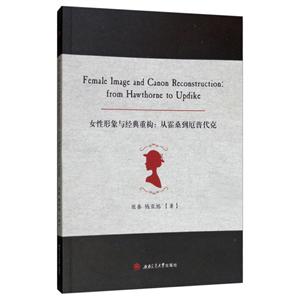女性形象与经典重构:从霍桑到厄普代克:from Hawthorne to Vpdike
本书特色
[
Literature is a mirror of social ideas and images. It possesses the power either to nourish or to discourage certain values and ideals. As the most noteworthy, exemplary and authoritative work of all literature, literary canon exerts greater influence in this respect. After all, literary canon is of setting models in the society. The word “canon” is originally derived from ancient Greek word “kanon”, a measuring rod, meaning standard. Later, when Christianity took root in Europe, literary canon was widely accepted as the Bible, which has been a major force in shaping the religious belief and even cultural tradition in Europe. In the eighteenth century, as literature accomplished its modem transition and became an independent discipline, literary canon also assumed more secular functions of teaching and guiding, among which maintaining a hierarchy family relation as well as social order was of priority. Hence, stereotypical views on gender relation were justified and reinforced by the depictions of men and women in literature canon. In this sense, literar)r canon is just a living fossil of anthropology, recording and preserving the social patterns in different ages. By exploring the change of the female image in the literary canon, we are more likely to form a panoramic view of women status as well as the social development in the history. Literature is a mirror of social ideas and images. It possesses the power either to nourish or to discourage certain values and ideals. As the most noteworthy, exemplary and authoritative work of all literature, literary canon exerts greater influence in this respect. After all, literary canon is of setting models in the society. The word “canon” is originally derived from ancient Greek word “kanon”, a measuring rod, meaning standard. Later, when Christianity took root in Europe, literary canon was widely accepted as the Bible, which has been a major force in shaping the religious belief and even cultural tradition in Europe. In the eighteenth century, as literature accomplished its modem transition and became an independent discipline, literary canon also assumed more secular functions of teaching and guiding, among which maintaining a hierarchy family relation as well as social order was of priority. Hence, stereotypical views on gender relation were justified and reinforced by the depictions of men and women in literature canon. In this sense, literar)r canon is just a living fossil of anthropology, recording and preserving the social patterns in different ages. By exploring the change of the female image in the literary canon, we are more likely to form a panoramic view of women status as well as the social development in the history.
American literature did not exist until the founding of the United States of America. Since then, a collection of literary canons has been selected and deemed important enough to be taught at schools, where the images of women have varied from time to time, from author to author. The portrayals of women in American literature are often affected by author’s personal experience and more frequently by the social stereotype of women and female position. In the early nineteenth century, Washington Irving depicted the only female character in Rip Van Winkle as a flat, aggressive and bothersome figure, which indicated a generally negative view on women at that time. Around a century later, as women won more rights in society, women were no longer portrayed as disgusting but still vulnerable as F.Scott Fitzgerald did with Daisy Buchanan, a victim in the 1920’s America.
]
目录
AbbreviationsChapter One Introduction1.1 Nathaniel Hawthome and 7he Scarlet Letter1.2 John Updike and The Scarlet Letter Trilogy1.3 Updike’s Trilogy and The Scarlet letter1.4 Methodology and StructureChapter Two Intertextuality and Intertextual Narration2.1 The Theory of Intertextuality2.2 Intertextual Elements2.3 IntertextuaI NarrationChapter Three Female Image: From Deviant to Human Being3.1 Hester vs.Sarah3.2 Pearls3.3 Other WomenChapter Four Female Image: From Silence to Monologue4.1 Women’s Silence in The Scarlet Letter4.2 Women’s Monologue in Updike’s TrilogyChapter Five Female Image: Pursuit of Self5.1 Various Attempts5.2 Failure of Pursuit5.3 Persisting Patriarchal ControlChapter Six Canon Reconstruction: Imitative Intertextuality6.1 Archetype6.2 The Magna Mater as Archetype6.3 The Myth of Eden as Archetype6.4 The Scarlet Letter as ArchetypeChapter Seven Canon Reconstruction: Transformative Intertextuality7.1 Hawthome’s Revision7.2 Hawthorne’s Voice7.3 Updike’s SubversionChapter Eight Canon Reconstruction: Cultural Intertextuality8.1 Women in American History8.2 Canon and Social Metaphor8.3 Duality and Women’s Awakening in the 19th Century America8.4 Fragmentation and Postmodernity in the 20th Century America……Chapter Nine ConclusionBibliography
封面

书名:女性形象与经典重构:从霍桑到厄普代克:from Hawthorne to Vpdike
作者:张秦,钱亚旭著
页数:133页
定价:¥45.0
出版社:西南交通大学出版社
出版日期:2019-04-01
ISBN:9787564368579
PDF电子书大小:126MB 高清扫描完整版
